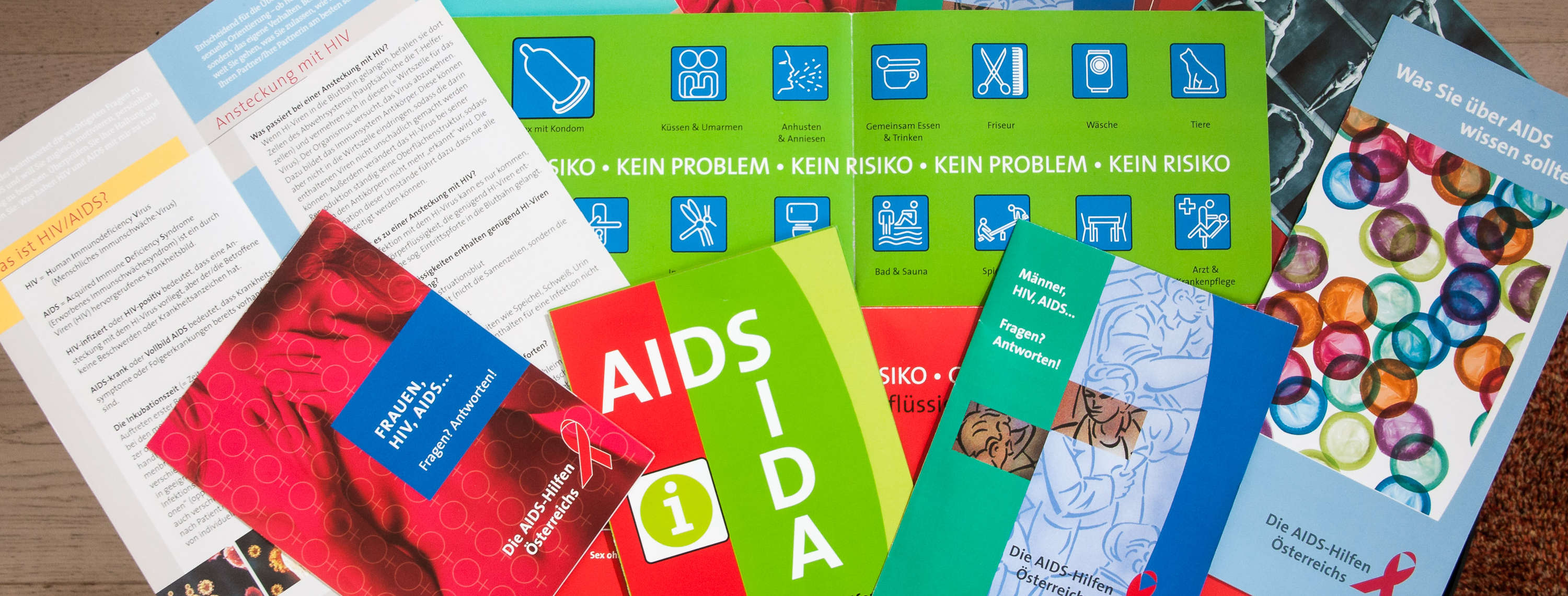HIV/AIDS
Basics
What does HIV mean?
HIV stands for Human Immunodeficiency Virus. It is a so-called retrovirus, which occurs exclusively in humans and can only be transmitted between humans.
HIV-postive means that there is an infection with the HI-Virus.
HIV-negative means that there is no infection with HIV.
Only a test can prove whether a person is HIV-positive or HIV-negative.
AIDS-Hilfe Steiermark provides HIV-testing anonymously and free of charge!
What does AIDS mean?
AIDS stands for Acquired Immunodeficiency Syndrome“.
Having AIDS means that due to an HIV infection the immune system is severly damaged and so-called AIDS-defining diseases occur, eg. various forms of cancer, pneumonia, fungal diseases, diseases of the brain etc.
HIV/AIDS: a significant distinction
A person is “HIV-positive” if HI viruses are found in the body. It is not before the immune system is severly limited and certain other diseases occur that the term “suffering from AIDS” applies. If HIV-infection is detected early enough, treatment with medication is possible and allows the affected person a long life with a chronic infection. Left untreated, AIDS can break out and leads to death. An early diagnosis of HIV and treatment as soon as possible are important.
HIV/AIDS
Means of transmission
HIV-infection only occurs when a body fluid, which is sufficiently contaminated with HI-viruses, encounters a so-called portal of entry. As a result, the HI-viruses are able to enter body and bloodstream.
Blood (also menstrual bleeding), seminal fluid, vaginal fluid and breast milk contain sufficient HI-viruses for infection. If one of these fluids enters the body via the mucous membranes (in eyes, nose, mouth, at the vagina, at the glans, in the anus) or open wounds, HIV-infection is possible.
Other body fluids such as saliva, sweat, urin or tears do not contain sufficient HI-viruses for infection. Consequently, kissing, caress of each other (including breasts, vagina, penis = petting) as well as holding hands is no risk for an infection – even so if one of the partners is HIV-positive.
Unprotected sex (oral, vaginal, anal intercourse) is the most common means of transmission for HIV-infection.
HIV/AIDS
HIV transmission during sex
-
Anal intercourse
The penis is inserted into the anus. The intestinal mucosa forms a very good portal of entry for HIV. Passive partners, especially, are at risk, in particular when ejaculation takes place inside the anus. But the risk exists for the penetrating partner as well.
-
Vaginal intercourse
The penis is inserted into the vagina. Mucous membranes inside the vagina and at the glans of the erect penis enable the virus to reach the bloodstream. Due to the high viral concentration of the seminal fluid and the large surface of the vaginal mucosa, the female body is at high risk of infection during vaginal intercourse. During menstruation the risk increases, also for the partner.
-
Oral intercourse
Oral sex means satisfaction of the partner with the mouth. The oral mucosa is permeable to HI viruses, meaning that it is a portal of entry for HIV. If semen of an infected man enters the mouth of the partner, there is a risk of infection. Precum (preejaculate) is not infectious due to the small amount of fluid. If vaginal fluid from an infected woman enters the mouth of the partner, there is no risk of infection because the amount of fluid is too small as well. However, if the vaginal fluid contains (menstrual) blood, there is a risk of infection. If an HIV-positive person pleasures someone with the mouth, there is no risk of infection for the partner.
HIV/AIDS
How can I protect myself against HIV infection?
Everyday social contact allowas no infection with HIV. During sexual intercourse, one can protect oneself and the partner by means of safer sex.
-
Vaginal intercourse (the penis is inserted into the vagina): always use a condom
Make sure that the condom was placed correctly before the first contact with the partner.
-
Oral intercourse (penis or vagina are orally satisfied): no seminal fluid or (menstrual) blood inside the mouth
If vaginal fluid from an infected woman enters the mouth of the partner there is no risk, unless it contains menstrual blood!
-
Anal intercourse (the penis is inserted into the anus): always use a condom and sufficient amount of lubricant (based upon water or silicone, non-fat only!)
Lubricants prevent the condom from bursting due to friction. Never use greasy creams or oils. These make condoms fragile!
How to properly use a condom?
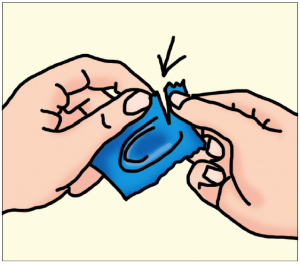
1. Open the package on the serrated side (do not use scissors, blades or teeth).
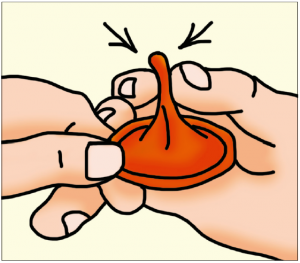
2. Check the roll direction (make sure that the condom can be unrolled outwards). Press the reservoir (condom tip) well together (3 fingers) so that there is no air in the condom (otherwise the condom may burst).
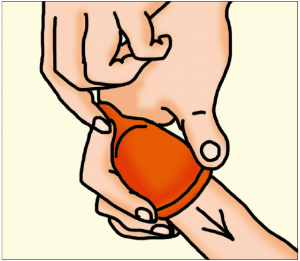
3. Hold the tip together well and roll the condom all the way down over the stiff penis.
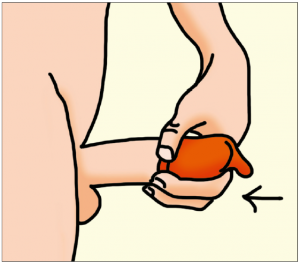
4. After ejaculation, hold the condom to the shaft – otherwise it may slip off the penis when pulled out.
The ten most common mistakes when using condoms are outlined in this video:
Kondome überziehen – Die häufigsten Fehler & wie es richtig geht (youtube)
Other means of transmission
Intravenous drug use
Most HIV transmissions from infected blood occur during drug use (“shooting up”) when the tools for consuming are shared. Thus, infected blood debris from the injection and needle can enter the bloodstream of the second user. In the absence of air, the HI virus can survive for several days in the needle and injection cavities.
Safer Use: Always use sterile injections for intravenous drug use. Never share injections and needles.
Information about the drug streetwork network and needle exchange programs in Graz: www.caritas-steiermark.at/hilfe-angebote/menschen-in-not/gesundheit/drogen-und-alkoholsucht/kontaktladen-streetwork-im-drogenbereich
Blood and products made out of blood
In Austria, the possibility of infection by blood or products made out of blood is almost impossible nowadays, as they are tested for HIV.
Tattooing and piercing
Mind hygiene standards when getting a tattoo and piercing.
Austrian tatoo studios have very high standards of hygiene, so there is no risk of infection.
Getting tattoos or piercings on holidays is not recommended if you do not know the hygiene standards.
Mother-to-child transmission
Usually, the HI virusis transmitted from an HIV-infected mother to the child at birth or during breastfeeding. Through medication, caesarean section and alternatives to breastfeeding, the risk of transmission can be reduced from about 25% to 1%.
No transmission in social interaction!
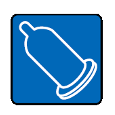
Sex with condoms

Kissing and hugging

Coughing and sneezing

Eating and drinking together

Hairdresser
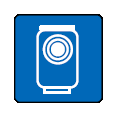
Laundry

Animals

Shake hands

Door handles

Insect bites

Toilet
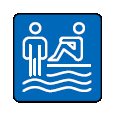
Bath & Sauna

Playground

Living together
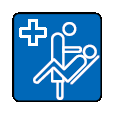
Doctors and nursing

